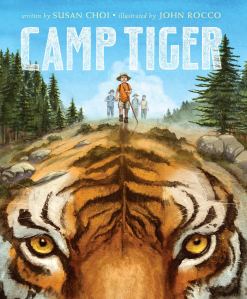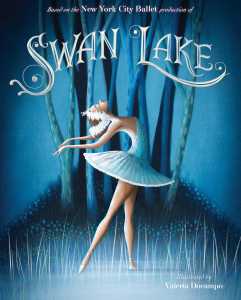We’re getting close to the part of the year when it’s time to think about what’s going to go on “Best of 2019” lists and what’s going to win awards. Just kidding; I think about “best of” lists and awards all year round. Here’s a list of a few of my favorite picture books that I’ve discovered since the last time I posted a list like this.
 Camp Tiger by Susan Choi, illustrated by John Rocco
Camp Tiger by Susan Choi, illustrated by John Rocco
Here we have a picture book for big kids. It has full paragraphs of text and the story leaves the reader with questions. Is the protagonist imagining the tiger the whole time? If so, why are the parents aware of the tiger? They’re not just playing along; the mom is actually the first one to see the tiger. But why isn’t anyone afraid of him? And then there’s the scene where the dad comments that their canoe is riding low in the water and the protagonist says it’s because of the tiger. The mom says, “You’ve grown, too”, as if she’s disagreeing about the tiger’s weight. I now have a new theory about the story. I think that the “tiger” is actually a feral cat that wanders into the campsite. The tiger’s appearance in the illustrations and everything that the tiger says is just the boy’s imagination, and their nighttime canoe ride is just a dream. (That part’s pretty obvious) But there is a real animal that the protagonist meets and bonds with on this camping trip. Regardless of how you interpret the plot, this book has gorgeous illustrations and emotional depth. The protagonist is unhappy about starting first grade soon, and I get the sense that his sorrow at leaving the tiger behind is a metaphor for growing up. So, in this case, I think this story is actually geared towards kids somewhat older than the protagonist. I’d recommend it for second and third graders, although it’s obviously much shorter than chapter books for that reading level.
Just Read by Lori Degman, illustrated by Victoria Tentler-Krylov
This rhyming picture book is essentially an ode to the hobby of reading, which may not be the most original and unique concept, but there are so many ways to do it well. In my personal opinion, Just Read comes out ahead of other similar books largely because of the artwork. There’s very little white space; the pictures are bright and detailed and busy. According to the note on the bottom of the copyright page, the illustrations are “created digitally and with watercolors”. The distinctive texture of the watercolor is evident, but these pictures have the vibrant colors and sharp, clear lines that would be more typical of ink drawings. Most of these pictures include both the characters and the imagery from the books they’re reading. Again, that concept is nothing new and groundbreaking, but it’s done well here. Meanwhile, the text is cheerful and fun and maintains its meter, which is always a plus for a rhyming story. I also appreciate the first person narrative voice, which avoids coming across as an imperative. This story isn’t commanding kids to read and judging them for not reading enough; it’s simply pointing out how much fun reading is. It’s a versatile book that would work well in a storytime, as a read-aloud at home, or as something for an older child to read independently.
The Key From Spain: Flory Jagoda and Her Music by Debbie Levy, illustrated by Sonja Wimmer
Flory Jagoda was a folk musician of Judeo-Spanish heritage who grew up in Bosnia and Croatia, then came to the United States after most of her extended family was killed in the Holocaust. This picture book biography gives some background history about the Ladino (Judeo-Spanish) people and the role that music played in their culture. It’s probably best suited for children old enough to have a little background knowledge about the historical setting. (At least enough to understand that the jump from the 15th/16th centuries to the 20th century covers many generations, and to know why Flory wouldn’t want strangers to know that she was Jewish.) Also, the significance of the titular key is somewhat abstract. But, with the caveat that this one is actually another picture book for big kids, it’s a beautiful and wonderfully informative book. I think that nonfiction picture books often lend themselves well to the task of introducing readers to obscure topics or less well-known figures, and this book is a good example.
 Swan Lake by the New York City Ballet, illustrated by Valeria Docampo
Swan Lake by the New York City Ballet, illustrated by Valeria Docampo
Most ballet picture books are stories about little girls or anthropomorphic animals in pink tutus, so it’s always nice to see books like this. Here, ballet is depicted not just as a cute hobby for young girls, but as an art form that tells a story. The illustrations are somewhat stylized, but realistic enough to remain true to the costumes, scenery, and choreography of the Swan Lake ballet. Because the plot comes from a ballet, (and originally from a Russian folk tale) and because of the large blocks of text, I’d consider this book to be nonfiction despite its picture book format. It also has a double page at the back with information such as the date of the original performance of Swan Lake, the names of choreographers who have created versions of the ballet, and fun facts about the costumes and sets of the New York City Ballet’s production. I’d recommend this book for elementary-school-aged children. In fact, teachers or parents who want to foster an appreciation for the arts would do well to show their child(ren) a video of the ballet immediately after reading the book together. (Or better yet, to go see the ballet performed live if you have the opportunity)
Pick a Pumpkin by Patricia Toht, illustrated by Jarvis
This is a wholesome, atmospheric, seasonal book about a family’s activities on Halloween. The first half (approximately) of the book shows them visiting a pumpkin patch, then they go home and carve jack-o-lanterns with their friends. Finally, they don their Halloween costumes, light a candle inside the jack-o-lantern, and go out trick-or-treat-ing. This is the kind of book that has appeal both for children and for the adults who read the book to them. It has a happily nostalgic vibe for those of us who have outgrown the days when Halloween pumpkins were more important than anything in our everyday lives. The illustrations are quintessentially autumnal with colorful leaves everywhere and an overall dark-toned color palette. (Also, the black cat is a nice touch. Black cats are always a plus.) I might be slightly biased because the author is a former coworker of mine, but I think that it’s fair to include it because it’s just as good as the other books on this list. I’m told that it has my little cousins’ stamps of approval.
A Stone Sat Still by Brendan Wenzel
This book comes from the same author/illustrator as They All Saw a Cat, which was one of my favorite books of 2016. (It was a Caldecott honor book) There’s something fundamentally similar about these two books, probably deliberately so, because they both center around the concept of showing a variety of perspectives. As the title indicates, this new title is about a stone, and the titular stone itself is motionless and unchanging while various animals come and go and the seasons change. In fact, even the shoreline moves and the stone is underwater by the end of the book. The text is sparse and simple, but there’s something profound about its calmness and its matter-of-fact depiction of change over time. I think it has less child-appeal than They All Saw a Cat, but it’s still worth attention. It wouldn’t shock me if it ends up with a Caldecott sticker on its cover, too.
 Because by Mo Willems, illustrated by Amber Ren
Because by Mo Willems, illustrated by Amber Ren
It’s always noteworthy when there’s a new book from Mo Willems, the author of dozens of popular books including Don’t Let the Pigeon Drive the Bus and the Elephant and Piggie series. Unlike many of Willems’ books, Because isn’t a silly story; it’s a beautifully written and inspirational description of the numerous events that came together to bring a young girl to the orchestra one night. (This list is very thorough; the chain of events begins with Beethoven composing the music that inspired Schubert to compose the music that the orchestra played) Spoiler alert: The girl grows up to become a composer and conductor herself. The text is simple and repetitive, which gives it a poetic sound, but the events listed vary enough to strike a nice balance between a sense of lucky coincidences and a positive message about success coming from hard work. The illustrations have a distinctive style that sets somewhat cartoonish people against backgrounds that play around with light and shadows, depth and perspective. The overall effect is that the art is detailed and precise, but if you look closely, it’s actually fairly simple, almost minimalistic. The music itself is depicted as a colorful ribbon of musical notation, adding an element of the abstract. This is a great book for introducing preschoolers (or slightly older kids) to music appreciation. It’s definitely on my radar for the next time I do a music-themed storytime.
The Night is Yours by Abdul-Razak Zachariah, illustrated by Keturah A. Bobo
Written in the second person, the text of this book is evidently a father speaking to his daughter Amani. It’s a hot summer night and Amani is playing outside with the neighborhood kids. When their game of hide-and-seek gets challenging and Amani can’t find one of her friends, the father admires her determination and patience. The father perceives a bond between his daughter and the moon, which is made most clear when the moonlight helps Amani find the last hide-and-seek player. The moon is mentioned frequently throughout the book and often described as if it’s a person. It’s happy and bright, but not quite as bright as Amani. Amani is also compared to the night itself, although the only specific reason given is that it’s because the night sky and her skin are both dark. There’s a sense that the characters’ African American identity is an important aspect of this book. This is one to keep an eye on for the Coretta Scott King awards.